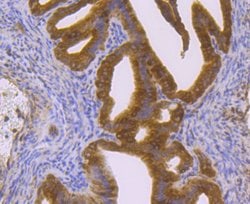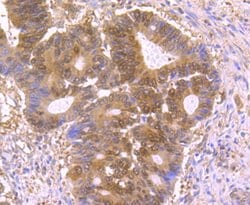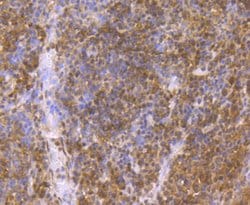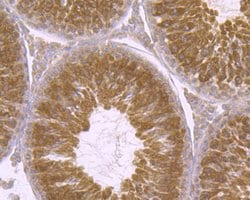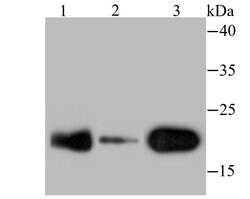Learn More
Invitrogen™ p23 Recombinant Rabbit Monoclonal Antibody (JU09-31)
Rabbit Recombinant Monoclonal Antibody
Supplier: Invitrogen™ MA532825
Description
Recombinant rabbit monoclonal antibodies are produced using in vitro expression systems. The expression systems are developed by cloning in the specific antibody DNA sequences from immunoreactive rabbits. Then, individual clones are screened to select the best candidates for production. The advantages of using recombinant rabbit monoclonal antibodies include: better specificity and sensitivity, lot-to-lot consistency, animal origin-free formulations, and broader immunoreactivity to diverse targets due to larger rabbit immune repertoire.
Steroid receptors are ligand-dependent intracellular proteins that stimulate transcription of specific genes by binding to specific DNA sequences following activation by the appropriate hormone. Prior to activation, steroid receptors associate with a number of different proteins in both a stable and transient fashion. Steroid receptor complex proteins include heat shock proteins (HSP70 and HSP90), immunosuppressant binding proteins called immunophilins (the FK506 binding proteins, FKBP52 & FKBP54 and the cyclosporin binding protein, CyP-40) and at least three other proteins termed p23, p60 and p48. p23 along with HSP70, HSP90 and p60, combine with progesterone receptor (PR) as members of a transient intermediate complex. Cloned human p23 encodes a protein of 160 amino acids that is highly conserved between species and shows no homology to previously identified proteins. p23 is a highly acidic phosphoprotein with an aspartic acid-rich C-terminal domain and multiple potential phosphorylation sites. In vitro studies have suggested that p23 binds to HSP90 and is necessary for the binding of HSP90 and CyP-40 to PR. While neither its exact function nor mechanism of action have been identified, p23 appears to be an important factor in PR function.
Specifications
| p23 | |
| Recombinant Monoclonal | |
| 1 mg/mL | |
| TBS with 0.05% BSA, 40% Glycerol and 0.05% sodium azide; pH 7.4 | |
| P83868, Q15185, Q9R0Q7 | |
| Ptges3 | |
| Synthetic peptide within Human p23 aa 43-92. | |
| 100 μL | |
| Primary | |
| Human, Mouse, Rat | |
| Antibody | |
| IgG |
| Immunohistochemistry (Paraffin), Immunoprecipitation, Western Blot, Immunocytochemistry, Western Blot | |
| JU09-31 | |
| Unconjugated | |
| Ptges3 | |
| 5730442A20Rik; Co chaperone p23; cPGES; cytosolic prostaglandin E synthase; cytosolic prostaglandin E2 synthase; Hsp90 co chaperone; Hsp90 co-chaperone; LOC100351480; P23; p23 cochaperone; progesterone receptor; progesterone receptor complex p23; Prostaglandin E synthase 3; prostaglandin E synthase 3 (cytosolic); prostaglandin-E synthase 3; Ptges; PTGES3; ptges3 {ECO:0000250; RGD1561913; sid 3177; Sid3177; Tebp; telomerase binding protein, p23; telomerase-binding protein p23; unactive progesterone receptor, 23 kD; UniProtKB:Q15185} | |
| Rabbit | |
| Protein A | |
| RUO | |
| 10728, 362809, 56351 | |
| Store at 4°C short term. For long term storage, store at -20°C, avoiding freeze/thaw cycles. | |
| Liquid |
Your input is important to us. Please complete this form to provide feedback related to the content on this product.


